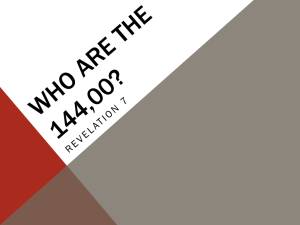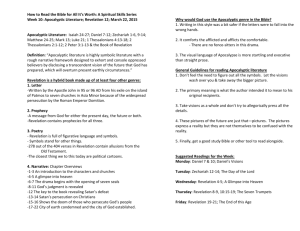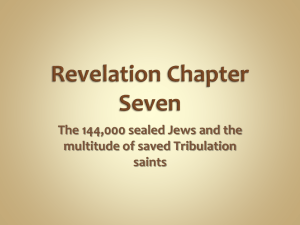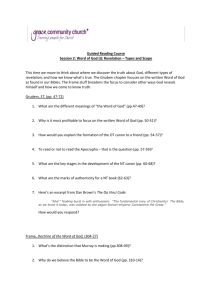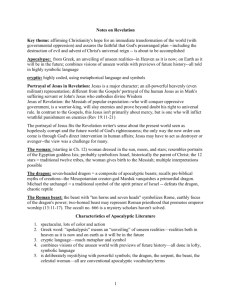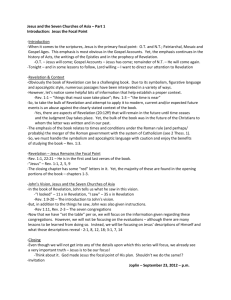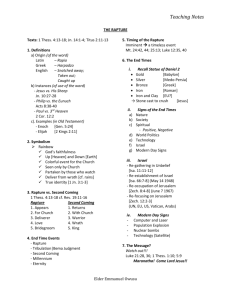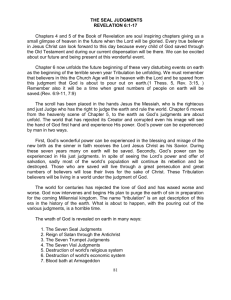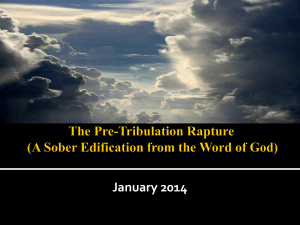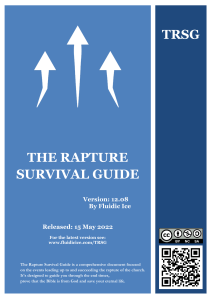Study Guide on the Left Behind series and the Book of Revelation
advertisement
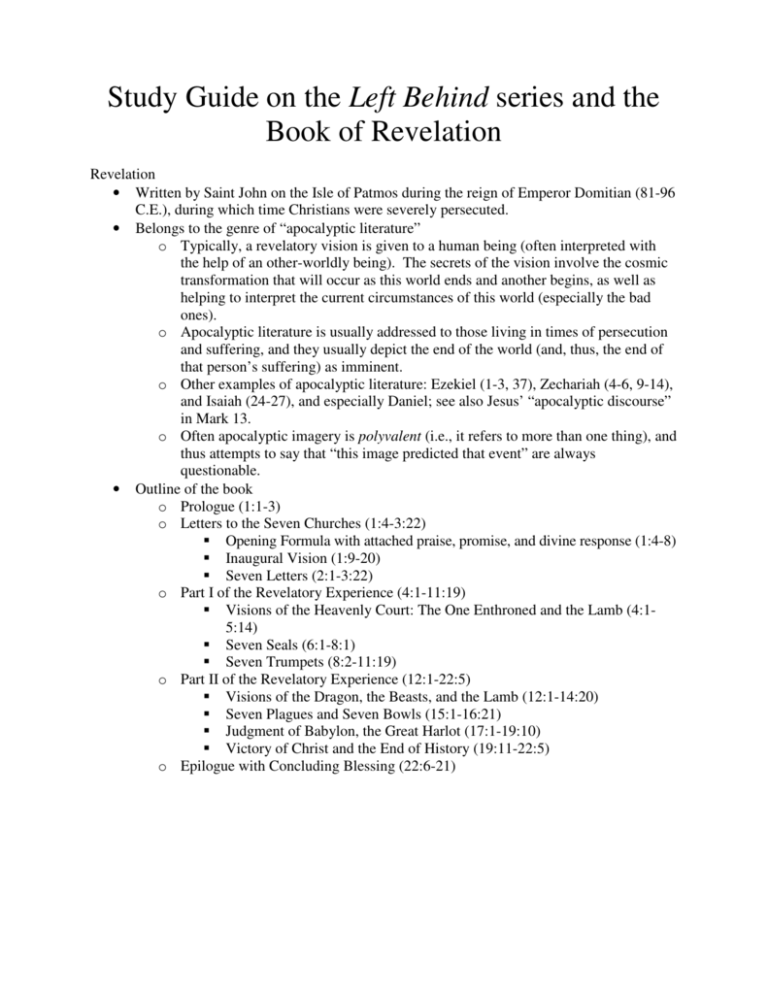
Study Guide on the Left Behind series and the Book of Revelation Revelation • Written by Saint John on the Isle of Patmos during the reign of Emperor Domitian (81-96 C.E.), during which time Christians were severely persecuted. • Belongs to the genre of “apocalyptic literature” o Typically, a revelatory vision is given to a human being (often interpreted with the help of an other-worldly being). The secrets of the vision involve the cosmic transformation that will occur as this world ends and another begins, as well as helping to interpret the current circumstances of this world (especially the bad ones). o Apocalyptic literature is usually addressed to those living in times of persecution and suffering, and they usually depict the end of the world (and, thus, the end of that person’s suffering) as imminent. o Other examples of apocalyptic literature: Ezekiel (1-3, 37), Zechariah (4-6, 9-14), and Isaiah (24-27), and especially Daniel; see also Jesus’ “apocalyptic discourse” in Mark 13. o Often apocalyptic imagery is polyvalent (i.e., it refers to more than one thing), and thus attempts to say that “this image predicted that event” are always questionable. • Outline of the book o Prologue (1:1-3) o Letters to the Seven Churches (1:4-3:22) Opening Formula with attached praise, promise, and divine response (1:4-8) Inaugural Vision (1:9-20) Seven Letters (2:1-3:22) o Part I of the Revelatory Experience (4:1-11:19) Visions of the Heavenly Court: The One Enthroned and the Lamb (4:15:14) Seven Seals (6:1-8:1) Seven Trumpets (8:2-11:19) o Part II of the Revelatory Experience (12:1-22:5) Visions of the Dragon, the Beasts, and the Lamb (12:1-14:20) Seven Plagues and Seven Bowls (15:1-16:21) Judgment of Babylon, the Great Harlot (17:1-19:10) Victory of Christ and the End of History (19:11-22:5) o Epilogue with Concluding Blessing (22:6-21) 2 In very broad strokes, different theories on Revelation are defined by how they answer three questions: 1. Literal or not? a. If you believe in the literal and selective interpretation of Revelation plus selections of a bunch of other books,1 you might be premillennial. b. If you believe in the general sense of Revelation (and if you don’t think that humanity is evil and powerless), you’ll probably be postmillennial.2 c. And if you think that Revelation is either historical (referring to Roman domination in the first century) or purely figurative, you’ll probably be amillennial (i.e., there won’t a literal thousand years, but it’ll be a while before Jesus returns). 2. Is humanity evil and powerless, or not? a. If you think humanity is evil and powerless, then we won’t be able to usher in the thousand year reign (if there really is one) on our own. We’ll need God’s help, and you’re premillennial. b. If you think humanity has some potential and we might be able to usher in the kingdom of God on earth, you’re postmillennial. 3. If you’re premillennial, do you think that Christians will suffer in the Tribulation? a. If you think so, you’re Post-Trib (i.e., the Rapture happens after the Tribulation). b. If you think Christians will be whisked up to heaven and won’t have to suffer through the Tribulation, you’re Pre-Trib. c. Note: Both of these are premillenial views, but the Left Behind series is decidedly Pre-Trib. But how do you reconcile a Pre-Trib view with Mark 13:9-13? History From the time of the Reformation up until the early part of the 20th century, postmillennialism was the dominant interpretation of Revelation. This view held that the Church could usher in the thousand-year reign of Christ on Earth, after which Jesus Himself would return. This was an optimistic view of human nature and earthly potential, and it was buoyed in the early part of the 20th century by fin de siècle optimism. Soon, however, events such as World War I and the Great Depression dampened this sentiment, and people began to feel that only God could save us (from ourselves). This led to the rise of premillennialism, which remains dominant in conservative circles to this day. 1 Remember: the Rapture is only mentioned in 1 Thessalonians, and the millennium is only mentioned in two verses of Revelation 20. 2 Some literal belief in the millennium was common in the early church (2nd and 3rd centuries), but it came to be felt that the expectations of future abundance and happiness were becoming too sensual and worldly. Thus, the Council of Ephesus (431) rejected such theories. Some major theologians of the early Church also rejected them, such as Origen (who thought the millennium was an allegory representing the spiritual kingdom of Christ on earth) and Augustine (who thought the first resurrection referred to conversion and death to sin, and didn’t have anything to do with the “Rapture”). 3 Chart of Postmillennialism John Nelson Darby (1800-1882) broke with the Anglican Church in 1830 to found a sect called the Plymouth Brethren. He described a view of premillennial view of history called dispensationalism, which segments God’s relationship with humanity into period of time during which we are subject to different divine laws and different criteria for salvation: 1. Innocence (Genesis 1:26-3:24): From Creation to the Fall. 2. Conscience (Genesis 4:1-7:24): Fall to the Flood. 3. Human Government (Genesis 8:1-11:26): Flood to Babel. 4. Promise (Genesis 11:27-Exodus 18): Babel to the Exile. 5. Law (Exodus 19:1-Acts 1:26): Exile to the Crucifixion. 6. Grace (Acts 2:1-Revelation 19:21): Crucifixion to Armageddon. This is where we’re supposed to be now. 7. Kingdom (Revelation 20:1-6): Sabbath of a thousand years. Darby was the first to systematically set forth Pre-Tribulation premillennialism, the belief that Jesus will return twice, seven years apart. The first time Jesus comes He’ll take Christians up to heaven with Him in the Rapture (1 Thessalonians 4:13-18). After seven years of tribulation on Earth (when ¾ of the people are killed, including all but 144,000 Jews), there will be the Glorious Appearing when Jesus establishes His earthly kingdom for all who’ve survived. A thousand years later, the Earth is destroyed and the Eternal State continues forevermore. Chart of Premillennialism (next page) (Note: This is a Post-Trib chart. The Left Behind series would place the Rapture before the Tribulation, with the second Second Coming of Jesus occurring just before the Millennium.) 4 Implications • • • • How invested should we be in our current lives? o Some so eagerly anticipate the arrival of the End Times that there’s not much reason to focus on things like world peace, or even saving for your child’s college education. o Rapture Index (a “Dow Jones Industrial Average of End Time activity”): Rates the probability of the Rapture’s coming based on prophetic indicators (such as apostasy and economic instability). This reached a high of 182 two weeks after 9/11 and a low of 93 at the end of Bill Clinton’s first year as president. It currently stands at 153. How much should we care for the Earth? o James Watt at his confirmation hearings as Secretary of the Interior, when asked about the effects of his environmental policies on future generations: “I don' t think we can count on too many more generations before the Lord returns.” Middle East politics o A literal, premillennial reading of Revelation often leads to a stance called “Christian Zionism,” whereby anything Israel does is seen as God’s will. Christian Zionists, for instance, oppose Israeli withdrawal from the Gaza Strip because Scripture states this belongs to Israel. The Zionists’ purpose is to ensure that all of Revelation’s prophecies are fulfilled so that Jesus can return. Many Jews are grateful for the support, not realizing that the supposed end result will be the eternal damnation of nearly every Jew. Interfaith dialogue (as it relates to Glorious Appearing, the final book in the Left Behind series) o Nicholas Kristof in the New York Times: “If a Muslim were to write an Islamic version of Glorious Appearing and publish it in Saudi Arabia, jubilantly describing a massacre of millions of non-Muslims by God, we would have a fit … It’s disconcerting to find ethnic cleansing celebrated as the height of piety.” o Response of Tim LaHaye: “Comparing my book Glorious Appearing to ‘fundamentalist Islamic tracts’ is a real stretch. The Islamic radicals who bomb the innocent are not nice people! … Should Christ overlook their rebellion and welcome them into his kingdom? They would ruin it for everyone. You don’t choose to live around people like that today; would you want to spend eternity with them? … The wonderful plan God has for the future of mankind may not be attractive to those who reject Christ, the Bible or God. But compared with plans for the future life (if any) taught by the other religions, it is the best thing going!”

